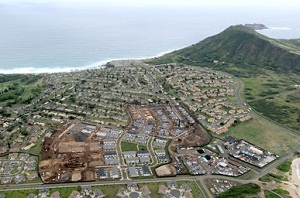Berthoud, Colo., planning for solar community
 The proposed solar-centric PrarieStar development in Berthoud, Colo., recently cleared another hurdle when the Berthoud Town Trustees gave it unanimous approval in October. But this project—first proposed in 2004—still has a ways to go before it sees the sun.
The proposed solar-centric PrarieStar development in Berthoud, Colo., recently cleared another hurdle when the Berthoud Town Trustees gave it unanimous approval in October. But this project—first proposed in 2004—still has a ways to go before it sees the sun.
Overall the development, proposed by developers Scott Sarbaugh and Richard McCabe, is expected to cover 190 acres, with 25 of them dedicated to a 4 megawatt photovoltaic installation that would provide power for the planned 854 residential units.
The development will include a research and development facility, retail and business buildings and an energy center where people could charge electric vehicles and more. Residential units in the development would range from the upper $100,000s to $600,000, according to The Denver Post.
While other “solar” communities have been developed prior to this one, the size and scope of Berthoud’s might be a first.
The development would be built in Xcel Energy’s service territory, said company spokesperson Mark Stutz.
He explained that under the proposal, PrairieStar would operate as a utility for its residents, selling them electricity from the PV array. The development “wanted to create a utility within a utility.” Which is illegal under Colorado law, he said.
While it might look cloudy for the project, it’s not over yet. The project could benefit from legislation passed in Colorado this year, allowing solar community gardens, said Tim Katers, Berthoud city planner.
Such gardens, which are owned by the community, were enabled under HB 10-1342, the Community Solar Gardens Utility Electric Standard, which allows solar generation facilities owned by 10 or more customers to generate and sell electricity to them.
Stutz also said the development could likely build the PV array through the community solar gardens law.
“These systems are still going to be built in our service territory,” Stutz said. “They’re going to have to be connected to our grid in some way.”
Under law, Xcel can only add 6 MWs of PV power through the program in a year, according to Stutz. That means that PrarieStar would have to compete with other solar gardens seeking interconnection agreements with Xcel throughout the state.
Stutz said that limiting integration of distributed solar will allow Xcel to better understand how large-scale solar interconnections will affect the grid.
“We want to see how the integration goes,” he said. “We still need to be concerned with costs associated with solar.”
The next step for PrairieStar is to submit a final proposal to the city, Katers said.
While the city has approved it, there still remain steps before this new community can be established, and there aren’t too many solar communities out there yet.
The issues facing the PrairieStar development are issues that are likely to reverberate throughout the U.S. as developers try to create more sustainable communities.
Pictured: No, Berthoud, Colo., is not a coastal town, yet. This is an example of another solar community, which, if you look closely, you can see arrays laid out. Image courtesy of NREL.



